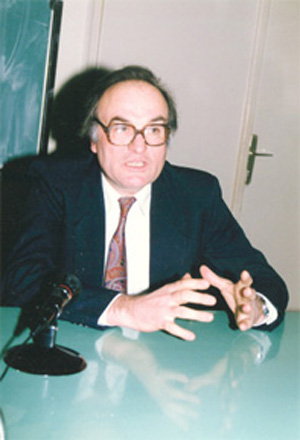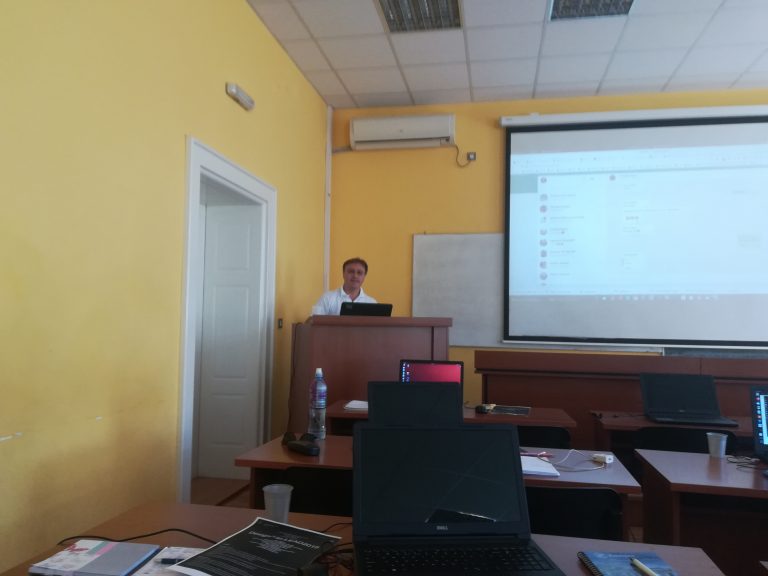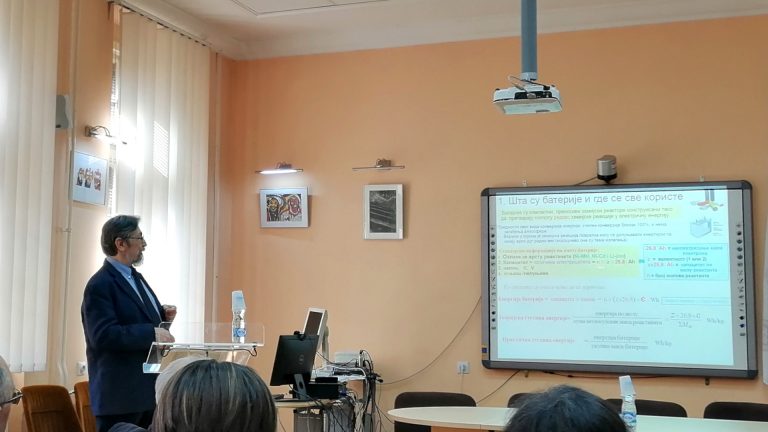
The United Nations (UN) has proclaimed 2019 as the international year of the Periodic system of chemical elements. This year, namely, has been turned 150 years from the publishing of Mendeleev’s Periodic system of elements. The interview was performed with Prof. Miloje Rakočević, the scientist, the most familiar in Serbia with the work of Mendeleev, and who gets into the essence of performed systematization.
Prof. Miloje Rakočević was working as a professor at the Department of Chemistry, Faculty of Sciences and Mathematics, University of Niš, and now he is retired. However, there is no obstacle for him to publish results in renowned journals, such as Biosystems and Polyhedron.
As a Deputy Editor of Chemia Naissensis, I felt free to put several questions on his desk connected to his work and Mendeleev’s Periodic systems of elements.
- Do you agree that the discovery of Periodic system of elements has brought closer chemistry to ordinary people to understand processes occurring in nature, and traced the path towards the quantum mechanics of orbitals and energy levels?
If ever and anywhere approaching of chemistry to ordinary people happened, it was undoubtedly in Russia, during Mendeleev’s life. So the highest honors are only for Mendeleev. Even in his early youth, after chemistry studies, Mendeleev started with the organization of numerous public lectures for people of all ages; he was literally “running” across the whole Russia, from Saint Petersburg to Moscow, and then to the Ural Mountains and Vladivostok, even to the Arctic. He measured that huge country by his own „steps“, visited many agricultural households, mines, oil fields, meteorological stations, industrial facilities („Science and industry-they are my dreams“). Also, he gave lectures everywhere, based on chemistry and „chemization“ of the environment, industry, and life.
From the above, it follows that the answer is affirmative on your question. What, after the discovery of periodic law and periodic system (after Mendeleev: chemical fundamentals) started right Mendeleev on the education plan and natural sciences enlightenments like the light it was spread worldwide. A good example is an application and animation in Serbia: our prominent scientist, lawyer, chemist, minister and rector of the University of Belgrade, Sima Lozanić was the first in Europe who introduced Periodic system into his chemistry textbook.
Regarding the second part of your question, the answer is also affirmative. The fact that Periodic table traced the path towards quantum mechanics of orbitals and energy levels now is, almost for decades, well known in chemistry; on this basis, all courses have been established, not only in university but also high schools’ chemistry teaching. Nevertheless, it needs to be said that regarding the presentation of the connection between natural law and electronic structure of the atom, there have been misunderstandings and uncertainties up to now. Thus, the periodic system of so-called „double structure“ („Double shell structure periodic system“) which comes from n+l rule about the addition of the principal and angular quantum numbers of V. M. Klechkovsky (Всеволод Маврикиевич Клечкóвский, 1900-1972) practically did not come to life. Without that rule, it is not possible to show that the Periodic system, among others, is determined with the golden ratio and Fibonacci’s series. D. N. Trifonov (Дмитрий Николаевич Трифонов, 1932-2010) showed that it is true, but, unfortunately, it was soon forgotten as well.
- Is it, in your opinion, this version the final version of the Periodic table? Does the Periodic table, in your opinion, need to reflect “fundamental” characteristics as electronic configuration, or chemical behavior?
Not only that it needs, it is-PS (Periodic System) is the fundamentals of chemistry. However, despite this fact, its structure and the composition, all the time, from the discovery up to now, shy away from a comprehensive view and understanding. The specific example is the position of lanthanides in PS. If the major characteristic of periodic law is shifting of odd and even positions (and it is!), in the sense that odd element is in the odd, and each even in the even group, how all 14 lanthanides can be in the same-the third group?! In the original Mendeleev’s table from 1900, it is not as that. According to Archive of Mendeleev, i.e., the corresponding book of B. M. Kedrov (Бонифатий Михайлович Кедров, 1903-1985), Mendeleev put the first lanthanide into the fourth (not the third group), and behind he left the place for 13 more lanthanides, with approximately accurate atomic weights, although two lanthanides then still have not yet been discovered, Pm and Lu (Table 16 in: Б. М. Кедров, Прогнозы Д. И. Менделеева в атомистике: неизвестные элементы, Атомиздат, Москва, 1977, p. 188; or in: Mendeleev’s Archive, www.rakocevcode.rs). Right from this fact I am starting in my newest article in Polyhedron, showing that PS of short periods must be as imagined by Mendeleev: each group with three subgroups of elements; today we would say with the transition, nontransition and inner transition elements.
I want to say that PS is always the same, with its displays in two or three dimensions; and because of the fact of the existence of multi-meaning and numerous aspects of interrelationships of elements alone, it was possible to present various and different types of periodic tables (3D System, sketched by hand of Mendeleev we have found in Mendeleev’s Archive; Photocopy XI in relation with Tables 13 and 18 in above quoted Kedrov’s book or in www.rakocevcode.rs).
- Do you think that for science is important to be at the right place at the right time? Do you think personally that Mendeleev’s creation of Periodic system of elements was influenced by the work of the Italian chemist Cannizzaro presented at the conference in Karlsruhe in 1860 on atomic weights?
It is true that it is important in science the right person to be at the right place exactly at the right time. Regarding Mendeleev, he was a man characterized par excellence by all these three headings. He was only 25 when he got the government scholarship for two years (1859-1860), “для усовершенствования в науках”, and already on the 9th January 1859 it was written “Решение Совета Петербургского университета о командировании Менделеева за границу”, where it was specified that he could immediately get on the road, with the possibility of moving across Europe, from Germany through France to Switzerland, and back. Nevertheless, Mendeleev stayed in Saint Petersburg three more months, primarily to finish his currently started paper “Замечание о коэффициенте капиллярности”, but also because of earlier promised lectures in chemistry “во Кадетком корпусе и Михайловской артиллерийской академии”.
From this reason young M.Sc. D. I. Mendeleev went on a path of improvement in science just on the 14th of April. The first “right” place was Warsaw and all its sights because he stayed there one full month. At the beginning of May, he arrived in Krakow and immediately visited nearby salt mine Wieliczka, one of the oldest in the world. Today it is a museum with many buildings, made of salt, among them is one magnificent church. It is the museum with more than two million visitors annually.
From Poland, Mendeleev stepped towards Germany, and he reached Dresden on the 12th May where he visited famous Dresden gallery of old masters, where during one visit it was possible to learn all about the European paintings from the 15th until the 18th century. Two days later he arrived in Leipzig, stayed there for two days, then one more day in Frankfurt am Main, in order to reach Heidelberg on the 22nd May, the place which he would determine as his permanent residence, during these two study years, and from where he would take shorter or longer trips across Europe, always as a right man in advance chosen places, where he could see a lot, find out and learn in science, art and culture. Mendeleev’s huge interest for all occurring in life and reality, as well as unobtrusive investigation curiosity, were exactly demanded.
Almost a day after arriving in Heidelberg he took emergency duties on building his laboratory, in a rented apartment. In mid-June, he turned around in Bonn in famous firm Kreisler to order the equipment for the determination of the density of liquids. He returned to Heidelberg to get dressed and hurried up to Paris where he spent almost a month and made an effort to connect with great masters-Salleron and Périgueux, and from them to order the equipment for the determination of density and the coefficient of fluid expansion, as well as surface supercharge of liquids.
Up to November, Mendeleev practically did not go out of the laboratory; he had his hand full of tasks. And then, he was visited by his friends and colleagues, peer A. P. Borodin (Алексáндр Порфирьевич Бородин, 1833-1887, chemist and general practitioner and future great composer) and five years older I. M. Sechenov (Ивáн Михáйлович Сéченов, 1829-1905, according to Pavlov “the father of Russian physiology”). In his letter to his family, Borodin will later write that Mendeleev possesses extremely good equipped, not so big „sweet“ laboratory, where „there is everything“, even gas; altogether, Mendeleev has excellent conditions to work on his Ph.D. thesis and maximize his work on the investigation of the fundamentals of chemical science.
At the end of December Mendeleev would together with these two future Russian „giants“ go to Paris, where they would primarily take rest and celebrate coming of the New 1860, and later (on the 2nd January 1860) go straight to the session of the French Academy of Science, where J. B. Dumas (Jean Baptiste André Dumas, 1800-1884), already then famous chemist, would present the newest work of young Mendeleev „О молекулярном сцеплении некоторых органических житкостей“.
At the end of summer the same year, precisely the 3rd-5th September, Mendeleev was, as a member of the delegation of Russian chemists consisting of N. N. Zinin (Николáй Николáевич Зинин, 1812-1880), L. N. Shishkov (Леон Николаевич Шишков, 1830-1909, a brilliant chemist and future general of the Russian Army), A. P. Borodin and others took part at the First International Congress of Chemists in Karlsruhe. Even he was elected for the member of the Trust (consisting of 30 members) which the task was the refinement of important questions which should be put on the discussion at the Congress.
At the Congress, different aspects were presented about the relation of atoms and molecules and atomic weights (masses). Congress was without the conclusion, and there was no official record. That was the reason why in public is little known about the holding of the Congress; it was reported with no newspapers, and, indirectly, by one-St. Petersburg’s newspaper, by announcing the letter which Mendeleev sent from the Congress to his professor A. A. Voskresenski (Александр Абрамович Воскресенский, 1808-1880, famous Russian chemist, known as “grandfather of Russian chemistry”; rector of the Saint Petersburg Imperial University (1861-1863 and 1865-1867)). The letter has a historical significance because besides Wurtz’s notes (Charles Adolphe Wurtz, 1817-1884, a great French chemist of German ancestry; his main area of the research was hydrocarbons and nitrogen-containing organic compounds) and later published memories of Lothar Meyer, it was the only indirect testimony about the Congress.
From the letter of Mendeleev to A. Voskresenski:
“It was elected the Trust of 30 members because of the previous elaboration of those questions (about atoms, molecules, equivalents, and formulae, as well as other sources which should be taken into account as a source of the chemical processes); in the Trust, it was, of course, S. Cannizzaro, which enthusiastic speech with the full right was received with general approval. On the second Congress meeting on the 4th September, the Trust submitted a resolution of the following content: „It was proposed to accept the distinguishing of term molecule from term atom; molecule as a quantity of substances participating in the reaction and determining the physical properties of the matter, and atom as the smallest quantity any substance can be contained in the molecule”. Heidelberg, 7 IX 1860”
Mendeleev got excited with new ideas which supported S. Cannizzaro and younger participants of the Congress. Later Mendeleev publicly claimed that the decisive impetus for his work on the Periodic system got exactly on this Congress in Karlsruhe and that he exactly then, based on Cannizzaro’s speech, concluded that the atomic weight is the essential constant according to which elements should be classified.
- How much, in your opinion, the previous attempts to make systematization of the elements influenced Mendeleev’s Periodic system of elements and does it need only Mendeleev to be highlighted, or there is a need for mentioning other his contemporaries when we talk about Periodic system of elements?
I think that all previous attempts are important for chemistry development and should be mentioned in studies of chemistry. It is the usual opinion that Mendeleev did not know the majority of them. I think opposite; Mendeleev had contacts with the majority of chemists in Europe and all these insights into the possible periodicity in the properties of chemical elements he could not overlook. The predecessors of Mendeleev need to be quoted, and in the order, they appeared with their ideas about the periodicity of chemical elements: J. Döbereiner, A. Chancourtois, J. Newlands, W. Odling, L. Meyer. But none of them, and all together, does not decrease the fame of Mendeleev. Different from any predecessors, Mendeleev discovered the law about the periodicity, and the system of elements, and not only the Table, which is the consequence of them both. Besides, Mendeleev predicted the existence of a significant number of elements, then not yet discovered (and not only scandium, gallium, and germanium, as frequently cited in chemistry textbooks), with the precise description of their properties. The way how he said, and wrote, represents not only the significant contribution to the chemistry but also the complete novelty in the science overall, the contribution to the methodology of the investigation in future science, in which predictions are the key criterion of the validation of scientific results. Finally, only Mendeleev fully and precisely indicated in which sense Periodic system represents the basis and essence of chemistry.
-
Does it exist chemical code, and is it implemented in the Periodic system of elements? What kind of analogy, in your opinion, exists between genetic and chemical codes?
Why I think that chemical code exists, and in which way its analogy with genetic code shows off, I ask our readers to look for the answer in two my newest papers. It is enough to read only the beginning of the first (Biosystems, Vol. 171, September 2018, pp. 31-47) and the end of the second paper (Polyhedron, Vol. 153, October 2018, pp. 292-298).



An impressive share! I have just forwarded this
onto a friend who was doing a little research on this.
Pretty! This was an extremely wonderful post. Thank you for supplying this info.
Oh my goodness! Awesome article dude!
I used to be able to find good information from your articles.
You are so cool! I don’t think I’ve truly read
something like that before. So nice to find someone with a few genuine thoughts on this issue.
Really.. thanks for starting this up. This website is one thing that
is needed on the internet, someone with a little originality!